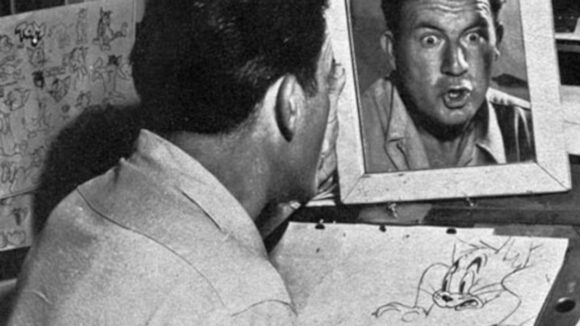

Animator Spotlight: Irven Spence
Today we’re going to turn our attention to one of the great animators of the Golden Age of Animation, Irven Spence. Thanks to animation drafts posted by historians like Devon Baxter, it’s possible to highlight the styles of individual animators and study their unique contributions.
Irv Spence is one of my favorite animators. He developed his kinetic style while working under Ub Iwerks and Tex Avery and he went on to animate the wildest moments in the Tom & Jerry cartoons of the 1940s and 1950s. In a series full of top-notch cartoon acting, Irv’s scenes give Tom & Jerry the widest range of expression. You can see his eye-bulging genius in this scene from The Mouse Comes to Dinner (1945).
— Cartoon Study (@CartoonStudy) August 10, 2023
Irv Spence’s approach was so distinctive that even as a kid, I could pick out his scenes without knowing his name. He gave his characters loopy, balloon-animal features with gigantic potato-shaped eyes that would often squash together. He drew rounded mouths that could slide up to any part of the character’s head, sometimes puckering into little pinched circles protruding off the chin. His furious use of speed lines gave his animation a comic strip feel. This Spence scene from the Tex Avery cartoon Little Red Walking Hood (1937) is so full of scribbly energy that the characters nearly explode off of the screen.
— Cartoon Study (@CartoonStudy) August 10, 2023
Tex Avery had many great artists in his unit in the late 1930s, but for my money, Spence was the only one who was able to “plus” the zaniness of Avery’s jokes with even zanier animation. You can see the difference between Spence and his peers in the Avery short A Sunbonnet Blue (1937): Spence’s animation of the Ratz Brothers (a spoof of the comedy team the Ritz Brothers) squashes and stretches with reckless abandon, while the non-Spence shots of ancillary mice are solid but commonplace in comparison.
— Cartoon Study (@CartoonStudy) August 10, 2023
Spence did his best-known work when he moved from Warner Bros. to MGM and started animating on William Hanna and Joseph Barbera’s Tom & Jerry cartoons. Spence was much looser about staying on-model than the other animators on the series, and the vibrant emotions he was able to portray really get you inside the heads of the characters. In this classic bit from Million Dollar Cat (1944), you can see many similarities to his Looney Tunes work, particularly the huge “crazy eyes” and curved teeth that resemble one of those Crocodile Dentist toys.
— Cartoon Study (@CartoonStudy) August 10, 2023
Irv Spence continued to animate well into his 80s, working for legendary figures like Richard Williams and Ralph Bakshi and serving as an animation director on tv series like A Pup Named Scooby-Doo. He retained his enthusiasm for the art form all throughout his life and was said to have a great sense of humor (while at MGM, he engaged in a tit-for-tat prank war with layout artist Harvey Eisenberg that sounds like something out of a Laurel & Hardy film). All of the Tom & Jerry animators were spectacular, but Spence’s work makes me laugh the hardest. I could end on any number of brilliant Spence scenes, but this bit from Springtime for Thomas (1946) is a particularly good example of his talent for raw emotion and inspired lunacy.
— Cartoon Study (@CartoonStudy) August 10, 2023
Thanks to Devon Baxter for his Animator Breakdowns

.png)